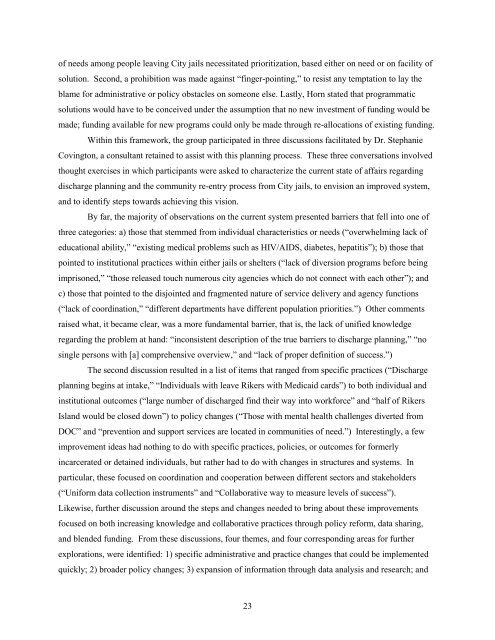Putting the Pieces Back Together: Overcoming Fragmentation to ...
Putting the Pieces Back Together: Overcoming Fragmentation to ...
Putting the Pieces Back Together: Overcoming Fragmentation to ...
You also want an ePaper? Increase the reach of your titles
YUMPU automatically turns print PDFs into web optimized ePapers that Google loves.
of needs among people leaving City jails necessitated prioritization, based ei<strong>the</strong>r on need or on facility of<br />
solution. Second, a prohibition was made against ―finger-pointing,‖ <strong>to</strong> resist any temptation <strong>to</strong> lay <strong>the</strong><br />
blame for administrative or policy obstacles on someone else. Lastly, Horn stated that programmatic<br />
solutions would have <strong>to</strong> be conceived under <strong>the</strong> assumption that no new investment of funding would be<br />
made; funding available for new programs could only be made through re-allocations of existing funding.<br />
Within this framework, <strong>the</strong> group participated in three discussions facilitated by Dr. Stephanie<br />
Coving<strong>to</strong>n, a consultant retained <strong>to</strong> assist with this planning process. These three conversations involved<br />
thought exercises in which participants were asked <strong>to</strong> characterize <strong>the</strong> current state of affairs regarding<br />
discharge planning and <strong>the</strong> community re-entry process from City jails, <strong>to</strong> envision an improved system,<br />
and <strong>to</strong> identify steps <strong>to</strong>wards achieving this vision.<br />
By far, <strong>the</strong> majority of observations on <strong>the</strong> current system presented barriers that fell in<strong>to</strong> one of<br />
three categories: a) those that stemmed from individual characteristics or needs (―overwhelming lack of<br />
educational ability,‖ ―existing medical problems such as HIV/AIDS, diabetes, hepatitis‖); b) those that<br />
pointed <strong>to</strong> institutional practices within ei<strong>the</strong>r jails or shelters (―lack of diversion programs before being<br />
imprisoned,‖ ―those released <strong>to</strong>uch numerous city agencies which do not connect with each o<strong>the</strong>r‖); and<br />
c) those that pointed <strong>to</strong> <strong>the</strong> disjointed and fragmented nature of service delivery and agency functions<br />
(―lack of coordination,‖ ―different departments have different population priorities.‖) O<strong>the</strong>r comments<br />
raised what, it became clear, was a more fundamental barrier, that is, <strong>the</strong> lack of unified knowledge<br />
regarding <strong>the</strong> problem at hand: ―inconsistent description of <strong>the</strong> true barriers <strong>to</strong> discharge planning,‖ ―no<br />
single persons with [a] comprehensive overview,‖ and ―lack of proper definition of success.‖)<br />
The second discussion resulted in a list of items that ranged from specific practices (―Discharge<br />
planning begins at intake,‖ ―Individuals with leave Rikers with Medicaid cards‖) <strong>to</strong> both individual and<br />
institutional outcomes (―large number of discharged find <strong>the</strong>ir way in<strong>to</strong> workforce‖ and ―half of Rikers<br />
Island would be closed down‖) <strong>to</strong> policy changes (―Those with mental health challenges diverted from<br />
DOC‖ and ―prevention and support services are located in communities of need.‖) Interestingly, a few<br />
improvement ideas had nothing <strong>to</strong> do with specific practices, policies, or outcomes for formerly<br />
incarcerated or detained individuals, but ra<strong>the</strong>r had <strong>to</strong> do with changes in structures and systems. In<br />
particular, <strong>the</strong>se focused on coordination and cooperation between different sec<strong>to</strong>rs and stakeholders<br />
(―Uniform data collection instruments‖ and ―Collaborative way <strong>to</strong> measure levels of success‖).<br />
Likewise, fur<strong>the</strong>r discussion around <strong>the</strong> steps and changes needed <strong>to</strong> bring about <strong>the</strong>se improvements<br />
focused on both increasing knowledge and collaborative practices through policy reform, data sharing,<br />
and blended funding. From <strong>the</strong>se discussions, four <strong>the</strong>mes, and four corresponding areas for fur<strong>the</strong>r<br />
explorations, were identified: 1) specific administrative and practice changes that could be implemented<br />
quickly; 2) broader policy changes; 3) expansion of information through data analysis and research; and<br />
23

















